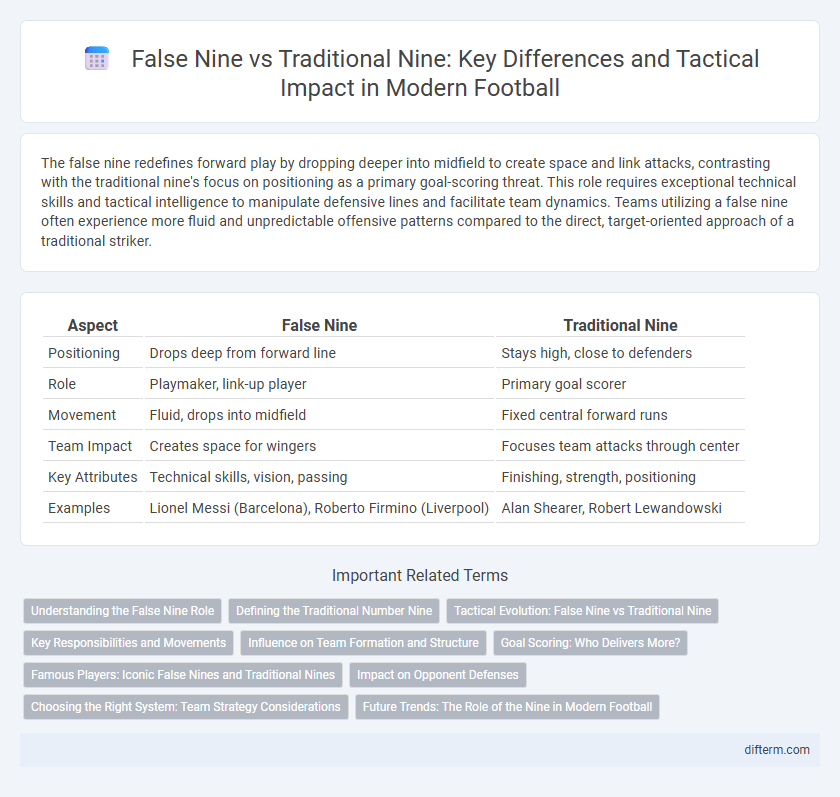The false nine redefines forward play by dropping deeper into midfield to create space and link attacks, contrasting with the traditional nine's focus on positioning as a primary goal-scoring threat. This role requires exceptional technical skills and tactical intelligence to manipulate defensive lines and facilitate team dynamics. Teams utilizing a false nine often experience more fluid and unpredictable offensive patterns compared to the direct, target-oriented approach of a traditional striker.
Table of Comparison
| Aspect | False Nine | Traditional Nine |
|---|---|---|
| Positioning | Drops deep from forward line | Stays high, close to defenders |
| Role | Playmaker, link-up player | Primary goal scorer |
| Movement | Fluid, drops into midfield | Fixed central forward runs |
| Team Impact | Creates space for wingers | Focuses team attacks through center |
| Key Attributes | Technical skills, vision, passing | Finishing, strength, positioning |
| Examples | Lionel Messi (Barcelona), Roberto Firmino (Liverpool) | Alan Shearer, Robert Lewandowski |
Understanding the False Nine Role
The false nine role redefines traditional forward positioning by dropping deeper into midfield, creating space and confusion among defenders. Unlike the traditional nine who stays high to finish chances, the false nine orchestrates playmaking and disrupts defensive lines through movement and ball distribution. Mastery of this role requires tactical awareness, technical skill, and the ability to link midfield and attack seamlessly.
Defining the Traditional Number Nine
The traditional number nine in football is a central striker who primarily acts as the team's main goal scorer, positioned closest to the opponent's goal. This player is often characterized by physical strength, aerial ability, and clinical finishing skills, serving as a focal point for attacking plays. The role emphasizes holding up the ball, linking with attacking teammates, and consistently converting scoring opportunities.
Tactical Evolution: False Nine vs Traditional Nine
The false nine revolutionizes football tactics by dropping deeper into midfield to create numerical advantages, contrasting with the traditional nine's primary role as a fixed target striker focused on finishing and physical presence in the box. This tactical evolution enhances fluidity, allowing the false nine to link play, drag defenders out of position, and open spaces for attacking midfielders and wingers. Teams adopting the false nine often demonstrate increased positional interchanges and unpredictability, challenging rigid defensive structures that traditional nines typically confront with direct runs and hold-up play.
Key Responsibilities and Movements
A false nine drops deeper into midfield to create space, linking play and drawing defenders out of position, while a traditional nine primarily remains the focal point of attack, occupying central defenders with constant forward runs. The false nine's key responsibilities include orchestrating play, facilitating overloads, and providing assist options, whereas the traditional nine focuses on goal-scoring, holding up the ball, and leading the attacking line. Movements of a false nine involve fluid, unpredictable positioning and short passes, contrasting with the traditional nine's direct, penetrative runs and physical presence in the box.
Influence on Team Formation and Structure
The false nine disrupts traditional team formation by pulling defenders out of position, creating space for midfielders and wingers to exploit, resulting in a fluid and dynamic attacking structure. In contrast, the traditional nine anchors the formation with a fixed central presence, providing a focal point for crosses and set-pieces while maintaining a clear offensive role. This tactical difference fundamentally alters the team's shape, pressing patterns, and transitional play, influencing overall strategy and player responsibilities.
Goal Scoring: Who Delivers More?
The false nine role often creates more goal-scoring opportunities through fluid movement and drawing defenders out of position, resulting in higher assist counts and space creation for midfielders. Traditional number nines typically focus on positioning inside the box to finish chances, leading to higher direct shot counts and clinical finishing stats. Statistical analysis shows traditional nines usually have superior goal conversion rates, while false nines contribute more to overall team chance creation.
Famous Players: Iconic False Nines and Traditional Nines
Lionel Messi exemplifies the iconic false nine role, utilizing his dribbling and playmaking to drop deep and create chances, contrasting with Diego Maradona, a traditional nine known for his powerful striking and clinical finishing inside the box. Francesco Totti also bridges these roles, adapting between a creative false nine and a classic forward, while traditional nines like Alan Shearer dominate with physicality and goal-scoring precision. The tactical impact of these players highlights the evolution of the striker position, where false nines emphasize fluidity and creativity, and traditional nines focus on direct goal threat.
Impact on Opponent Defenses
The false nine disrupts opponent defenses by withdrawing from the central forward position, drawing center-backs out of their line and creating space for midfielders and wingers to exploit. Traditional nine forwards maintain a fixed advanced position, forcing defenders to mark closely and allowing less room for tactical fluidity. This positional variance of the false nine often leads to defensive confusion, breaking rigid defensive structures and increasing attacking unpredictability.
Choosing the Right System: Team Strategy Considerations
Selecting between a false nine and a traditional nine hinges on a team's tactical approach and player skill sets. The false nine, known for dropping deep to link play and create space, suits teams emphasizing fluid passing and positional interchange, while a traditional nine excels in holding up play and finishing inside the box. Coaches must evaluate squad composition, opponent weaknesses, and game scenarios to align the striker role with broader strategic objectives.
Future Trends: The Role of the Nine in Modern Football
The evolution of the nine in modern football is shifting towards versatility and fluidity, with false nine strikers playing a pivotal role in disrupting traditional defensive structures. Tactical data reveals a rising preference for false nine roles due to their ability to drop deep, link play, and create space for wingers and midfielders, enhancing attacking unpredictability. Future trends indicate that teams prioritizing adaptable forwards and dynamic positioning will outperform rigid traditional nine systems in high-press and possession-based styles.
false nine vs traditional nine Infographic

 difterm.com
difterm.com